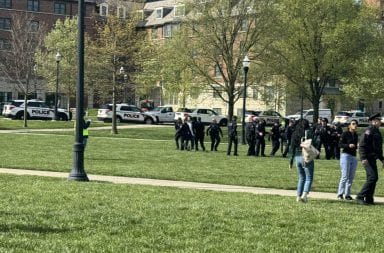
Dr. Quinn Capers IV (middle) makes hospital rounds with four doctors he admitted to medical school | Credit: Courtesy of Quinn Capers
What Dr. Quinn Capers IV will miss most about Ohio State is the people.
Capers, vice dean for faculty affairs at the College of Medicine at Ohio State and former associate dean for admissions, left after more than 10 years at the university earlier this month.
Capers said he will miss mentoring medical students as he transitions to working primarily with faculty as the associate dean of faculty diversity at the University of Texas Southwestern Medical Center.
“There’s some people now who are cardiology fellows — these are trainees who’ve been out of medical school for five or six years — that I admitted to medical school. And that’s really something special,” Capers said. “I will miss that in my new role.”
He said among the high points of his time at Ohio State, two moments stand out: being named “Professor of the Year” in 2019 by the graduating class and receiving patient satisfaction scores in the 90th percentile nationwide for the past six years.
“I’ve got a trophy case full of awards and plaques, medals. But for a doctor, there’s no higher honor than your patients thinking you’re doing a good job,” Capers said.
Capers specializes in interventional cardiology, but he said he got involved with teaching and admissions to have a larger impact on reducing racial health care disparities by increasing diversity among the medical workforce.
“As the dean of admissions, I really had an opportunity to try to do something to make a change,” Capers said. “We put in place several strategies, and it changed the mindset of how we think about admissions and diversity and how really having a more diverse class will make Ohio State a better medical school.”
One such change occurred in 2012, when Capers tested the implicit biases of the medical school’s 140 admissions committee members. The study results showed 50 to 70 percent of the admissions committee unconsciously held racial and gender biases.
Capers said these unconscious biases could present admission process issues, potentially causing members to judge the credentials of certain applicants harshly and not grant them the same interview experiences as their peers.
Following the results of the study, Capers said the admissions committee held trainings to develop strategies to reduce and overcome implicit biases. He said the next admitted class was the most diverse of the college’s history at the time.
“He really completely transformed our ability to improve the recruitment of underrepresented minorities into medicine, which was really dramatic,” Daniel Clinchot, vice dean for education in the College of Medicine, said. “Prior to his work, the average percent of underrepresented minorities in the class was about 13 percent, and he advanced it up into the 20s — 24 to 25 percent.”
Capers said he is a certified implicit bias workshop moderator and has helped other medical schools across the U.S. with their implicit bias testing and mitigation. Implicit bias testing is now provided every year for leadership, faculty and staff of both the College of Medicine and the Wexner Medical Center, according to the college’s website.
“Of all the things we do to enhance diversity, that, I think, has been one of the most transformational or impactful,” Capers said.
Along with his work to make the college more inclusive, Capers said he also focused on strong leadership, including consensus-based decision making and mentoring underrepresented students, helping the medical students learn and see success in the program.
“There’s not a friend he hasn’t met. He is somebody that is so engaging and easy to talk to, and he’s outgoing and gregarious,” Clinchot said. “You take an immediate liking to him when you meet him. He has one of those personalities. And so I think as a leader, people want to work with him to make change.”
At UT Southwestern, Capers will also serve as the inaugural vice chair of diversity in the Department of Internal Medicine while still practicing interventional cardiology.
Capers said he wants to increase the diversity of residents, fellows and faculty at UT Southwestern and in his roles will be enhancing diversity and inclusion efforts in education and patient care at the university.
“I’m excited to work with others to build a consensus, to work on a mission and to do some of the same things there that we were doing here,” Capers said.
Capers said his work with colleagues at Ohio State will continue, as he plans to find ways for the two universities to collaborate.
“I’ll continue to learn from Ohio State, and hopefully now with me as a conduit, Ohio State can learn some of the things that UT Southwestern is doing,” Capers said. “Because in the end, it’s not about one medical center being ‘better than the other.’ We’re all in this business to help patients.”
Clinchot said the school will miss Capers’ ability to engage others and his overall impact on faculty, staff and students.
“The biggest thing that we will miss here in the college is his mentorship and advocacy,” Clinchot said. “And I think that they will be hard shoes to fill.”
Despite this, Capers said he is comfortable leaving the university, knowing of the medical center’s great leadership and its launching of anti-racism initiatives.
“One of the things that you want to do as a leader, you want to be sure you have your impact on a place so that when you leave, that place continues to do the great things. It will be a leadership failure for you to really instill a lot of wonderful strategies and processes at a place, and then as soon as you leave they go away,” Capers said. “I’m very confident and very optimistic that Ohio State is going to continue to be a leader in diversity, inclusion and a force to be reckoned with in terms of fighting healthcare disparities.”


